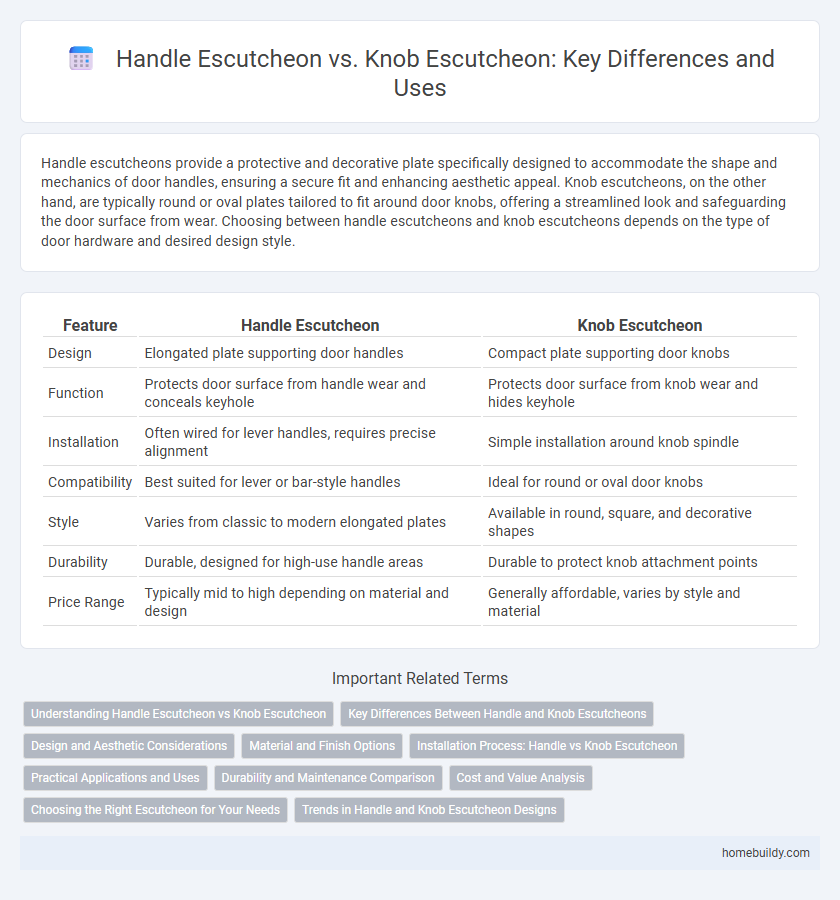Handle escutcheons provide a protective and decorative plate specifically designed to accommodate the shape and mechanics of door handles, ensuring a secure fit and enhancing aesthetic appeal. Knob escutcheons, on the other hand, are typically round or oval plates tailored to fit around door knobs, offering a streamlined look and safeguarding the door surface from wear. Choosing between handle escutcheons and knob escutcheons depends on the type of door hardware and desired design style.
Table of Comparison
| Feature | Handle Escutcheon | Knob Escutcheon |
|---|---|---|
| Design | Elongated plate supporting door handles | Compact plate supporting door knobs |
| Function | Protects door surface from handle wear and conceals keyhole | Protects door surface from knob wear and hides keyhole |
| Installation | Often wired for lever handles, requires precise alignment | Simple installation around knob spindle |
| Compatibility | Best suited for lever or bar-style handles | Ideal for round or oval door knobs |
| Style | Varies from classic to modern elongated plates | Available in round, square, and decorative shapes |
| Durability | Durable, designed for high-use handle areas | Durable to protect knob attachment points |
| Price Range | Typically mid to high depending on material and design | Generally affordable, varies by style and material |
Understanding Handle Escutcheon vs Knob Escutcheon
Handle escutcheons are typically elongated plates designed to fit around door handles, providing protection and enhancing aesthetics, while knob escutcheons are usually circular or oval, tailored to encircle door knobs. Handle escutcheons often accommodate locking mechanisms and keyholes, offering both functionality and decorative appeal, whereas knob escutcheons primarily focus on covering the knob base and concealing mounting hardware. Choosing between handle and knob escutcheons depends on door hardware type, security needs, and design preferences for a cohesive look and optimal performance.
Key Differences Between Handle and Knob Escutcheons
Handle escutcheons are designed to accommodate lever-style door handles, providing a larger, often rectangular or oval plate that enhances grip and lever operation. Knob escutcheons are typically smaller and round, tailored to fit around the base of a door knob, focusing on a clean, compact aesthetic. Key differences include their shape compatibility, size, and the functional support they provide for the respective hardware types.
Design and Aesthetic Considerations
Handle escutcheons typically feature elongated shapes that complement lever handles, enhancing sleek and modern door designs with clean lines. Knob escutcheons are often circular or oval, providing a classic or traditional aesthetic that harmonizes with rounded door knobs. Both types can incorporate decorative elements such as embossing, finishes, and textures to elevate the overall visual appeal and match diverse interior styles.
Material and Finish Options
Handle escutcheons are typically made from sturdy metals like brass, stainless steel, or zinc alloy, offering finishes such as polished chrome, brushed nickel, and antique bronze for durability and style. Knob escutcheons often utilize similar materials but include a wider range of decorative finishes, including matte, satin, and enamel-coated options to complement various interior designs. Both types prioritize corrosion resistance and aesthetic appeal, with finish choices tailored to either modern or traditional hardware styles.
Installation Process: Handle vs Knob Escutcheon
Handle escutcheons typically require precise alignment with the handle mechanism, often involving multiple screws or bolts to ensure stability and proper operation, which can make the installation process more complex. In contrast, knob escutcheons usually involve a simpler installation procedure, often just a single screw or snap-on mechanism, making them quicker and easier to mount. Both types demand careful fitting to door thickness and backset measurements to guarantee secure attachment and functionality.
Practical Applications and Uses
Handle escutcheons are primarily used to cover and protect the area surrounding door handles, providing a neat finish and preventing wear from frequent gripping. Knob escutcheons serve a similar function around door knobs but are designed to accommodate the rotational movement and may include additional features for keyholes or lock mechanisms. Both types enhance durability and aesthetic appeal in residential and commercial door hardware installations.
Durability and Maintenance Comparison
Handle escutcheons typically offer greater durability due to their robust construction and reinforced mounting plates, making them ideal for high-traffic areas. Knob escutcheons, while often easier to clean and maintain because of their simpler design, may wear faster under frequent use due to thinner materials. Regular maintenance for handle escutcheons involves tightening screws and lubricating moving parts, whereas knob escutcheons primarily require surface cleaning and occasional polishing to maintain their appearance.
Cost and Value Analysis
Handle escutcheons generally cost more due to their larger size and more complex design compared to knob escutcheons, which are smaller and simpler to produce. Despite the higher upfront price, handle escutcheons provide greater value in applications requiring enhanced durability and ergonomic grip, often resulting in lower replacement frequency. Knob escutcheons offer an affordable option for decorative or light-use settings, delivering cost-effectiveness but with potentially reduced longevity and less functional support.
Choosing the Right Escutcheon for Your Needs
Selecting the right escutcheon depends on the type of door hardware, with handle escutcheons designed for lever handles and knob escutcheons tailored for round or oval knobs. Handle escutcheons typically provide a larger surface area for added protection around the handle mechanism, while knob escutcheons focus on fitting snugly around the circular base of the knob. Consider the door's style, usage frequency, and the hardware's dimensions to ensure optimal functionality and aesthetic compatibility.
Trends in Handle and Knob Escutcheon Designs
Handle escutcheons commonly feature sleek, elongated designs that complement modern minimalist doors, emphasizing functionality and clean lines. In contrast, knob escutcheons often showcase intricate patterns and vintage-inspired motifs, catering to traditional and rustic interior styles. Current trends reveal an increasing preference for matte finishes and mixed materials like brass combined with matte black, enhancing both handle and knob escutcheons' aesthetic appeal.
Handle Escutcheon vs Knob Escutcheon Infographic

 homebuildy.com
homebuildy.com